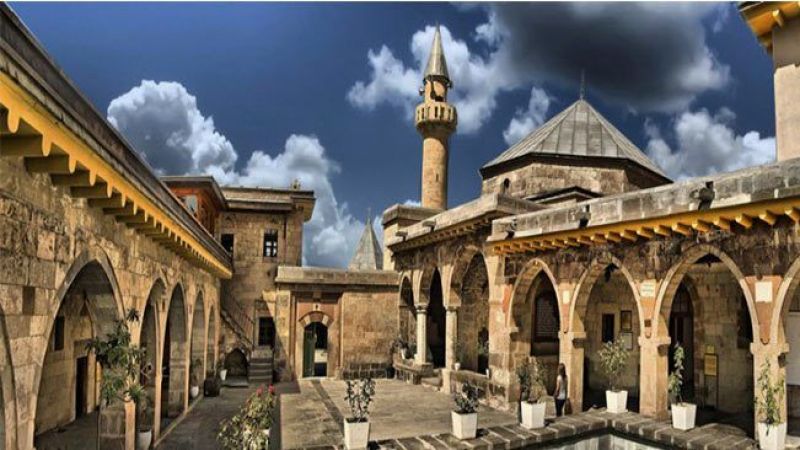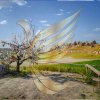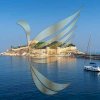Hacibektas, is 40 minutes drive from Goreme, situated in northern Cappadocia. It is the focal point of Bektasi organization of Islam established by the extraordinary scholar Haci Bektas-I Veli in thirteenth century. You can visit the dervis dergah (stop) which is an exhibition hall today, cilehane (enduring house), bestaslar (five stones) and a cemevi (an alevi sanctuary) in Hacibektas. In the event that your visit is planned for August, you will have the option to watch the global celebration functions, and get a thought of the living conventions of the request’s supporters. Hacibektas is the holy focal point of Alevi Islam, and consistently on 16, 17 and 18 August, a huge number of individuals rush here, from Turkey, however from Bulgaria, Albania and other Balkan nations.
HACI BEKTAS-I VELI
” How happy for the individuals who shed light into the obscurity of thought. ”
These words, composed by Haci Bektas-I Veli, the popular Turkish-Islamic spiritualist, logician, and dervish from Khorasan, reverberation carefully in our ears as we enter the dervishes’ religious community. The lines, laden with importance, bestow harmony and love to our spirits and transport us to the universes totally not quite the same as our own. The stamp of Haci Bektas-I Veli’s engraving upon Turkish, Islamic, and world history is profound and unequaled. Let us, in this way, endeavor to get familiar with and build up a sense for his reality, filled all things considered with affection for mankind and for the universe, always remembering this is the way of adoration, the way of harmony, the way of information, the way of conviction.
Hacibektas Museum, CappadociaIn Khorasan’s city of Nishabur, in all likelihood in the years somewhere in the range of 1243 and 1248, a child was destined to Seyyid Ibrahim Sani and his better half Hatern Hatun, the little girl of Sheik Ahmet. His mom’s sympathy and his dad’s affection for uniformity and humankind were the establishments whereupon his childhood was based and such suppositions educated and improved his childhood years. His examinations under the tutelage of Hoca Ahmet Yesevi of Turkestan outfitted him with an information on positive scielices and in the school of his renowned rationalist tutor, he considered science and material science alongside writing and reasoning. Under Sheik Lokman Perende, one of Ahmet Yesevi’s successors, he contemplated supernatural quality. From crafted by the artist Omar Khayyam, Feridettin Attar, and Sheik Numan he took his motivation. Khorasan had a huge social legacy that had fed numerous a researcher and logician. Haci Bektas-I Veli finished his investigations in Khorasan, obtaining from them an expansive and amicable perspective on the world. His instruction supported this youthful Islamic spiritualist to turn out to be better familiar with humankind, and Haci Bektas-I Veli started to look for the fire of unending affection inside himself. Turning into a notable Sufi, he set out from Khorasan to make the journey to Mecca. Leaving Mecca, he made a trip to Syria and afterward proceeded with his excursions in Persia, Iraq, and Arabia. During these years, Anatolia was in a condition of serious political and monetary confusion. Haci Bektas-I Veli was influenced by this circumstance and came to Anatolia with reestablishing divided Turkish solidarity, and partook in the push to make the landmass a Turkish and Muslim country.
The standards and components of Haci Bektas-I Veli’s way of thinking and life turned into the establishment on which the Bektashi dervish request created. Bektashism depended on four precepts or “entryways”:
- the Door of the Shariah (Religious Law),
- the Door of Mysticism,
- the Door of Truth,
- also, the Door of Spiritual Knowledge.
Sema Dance, Hacibektas, CappadociaIn their Ceremony of Confession, Bektashis promised to be capable “for their hands” (the things they do), “for their flanks” (their wants), and “for their tongues” (what they state). This promise was an amazing and significant articulation of the conviction that one’s ought to be diverted towards affection and regard. Love of God and love of man lie at the establishment of Haci Bektas-I Veli’s way of thinking. Right now, spiritualist analyzed the universe that the Creator had made. Decides that nature had decided a large number of years prior were similarly as appropriate as ever in an endlessness wherein cordiality and viciousness grasped. Since it appeared, humankind has been the best spectator of an ideal request. Right now, is a safely tied down chain of rule and request. Haci Bektas-I Veli was profoundly affected by the flawlessness, amicability, and request that he saw known to man.
The absolute most known sayings of Haci Bektas-I Veli are:
Look for and find. Try not to hurt regardless of whether you are harmed yourself.
Teach your ladies. Control your deeds, tongue, and wants.
Whatever you look for, search for it in yourself. The proficient are both unadulterated and refining.
The initial step of an ability is unobtrusiveness. An individual’s flawlessness lies in the excellence of what he says.
Denounce no country or individual. Try not to force on somebody that which is unreasonably difficult for him to hold up under.
The stopping point that doesn’t go through information is dimness. How happy for the individuals who shed light into the dimness of thought.
Prophets and holy people are God’s blessing to mankind.
HACI BEKTAS-I VELI MUSEUM, THE DERGAH
Hacibektas Museum, CappadociaWhen you visit the Dervish Dergah (stop) in the focal point of the town, you will be acquainted with the Alevi request, one of the greatest heterodox parts of Islam. The Dergah or Dervish hotel of Hacibektas turned into a gallery in 1964. The passage leads into an enormous patio, to one side of which once stood structures obliging the dervishes who worked the land and ranch workers utilized by the cabin. These structures were crushed when the hotel was being changed over into a historical center, and a divider was worked here. At the furthest finish of this divider is the Ucler Fountain symbolizing the Creator, Muhammed and Ali, a key idea of the Alevi confidence. An open space on the left resembles a little park, and initially there were stables for the ponies of visitors, horse shelters and different storehouses here. Toward the finish of the yard a door leads into a subsequent patio, where there is a pool with a fringe of blossoms. You can drink from the sacred water of the Lion Fountain. The engraving over this wellspring clarifies that the lion statue was brought from Egypt as a blessing to the cabin in 1853. The subsequent yard was the busiest piece of the hotel, with the asevi (refectory), wash room, hamam (showers), visitor house, lobby where the holy administrations known as cem were held, and the structure where the cabin’s head, the Dedebaba, got visitors. The last portal leads into the third yard where the tomb of Haci Bektas Veli stands. On the privilege are the graves of dervishes having a place with the hotel, and in the little tomb just past falsehood Balim Sultan and Kalender Sah, two extraordinary figures of the request. The antiquated wishing tree before the tomb is one of the spots where guests stop. Before entering the tomb it is standard for guests to grasp the round and hollow marble stone in the right-hand corner. On the off chance that you can grasp it with two arms, at that point it is viewed as confirmation that your heart is spotless and your expectations are unadulterated. The tomb was worked by Seyhsuvar Ali, ruler of the Dulkadirogullari realm, in 1519 after the demise of Balim Sultan.
Lion Fountain, Hacibektas, CappadociaThe dividers of the catacomb are improved with painted kalem isi, and there are instances of Bektasi calligrapher. The entryway is unique. The catacomb of Haci Bektas Veli himself is known as Pir Evi, and at the passage are the graves of the baba’s of the request, dervishes who achieved the most elevated degree. As you stroll towards the Kirklar Meydani lobby, on the correct you pass the cilehane, a cell where the dervishes invested energy alone within the sight of God. On the off chance that you wish to see inside you should twist practically twofold, and a couple of moments alone in that dull cell gives you an impression in any event of what it probably been similar to for the dervishes who came here. On the raised stage to one side of the Kirklar Meydani are covered the relatives of Haci Bektas who sat on the stately downy of office and were known as celebi or bel evlatlari. Right now the dervishes played out the formal move known as the kirklar semahi, are presently shown the twelve sided stones known as teslim tasi which the dervishes stuck around their necks as images of the Bektasi request, hoops worn by unmarried dervishes who dedicated their lives to serving their cabin, penmanship of the Caliph Ali on gazelle skin, wonderful instances of calligraphy, lights, censers, and the Kirkbudak Candelabra which as indicated by the Velayetname originated from India. At long last a little entryway on the correct leads into the tomb load of Haci Bektas Veli, where guests perambulate multiple times around the stone casket before presenting a supplication to Haci Bektas Veli. Close to the hotel is Dedebagi, an open park dissipated with trees, where guests who have wanted the recognition functions accumulate to cookout and drink the super cold spring water from a wellspring known as Sekerpinar.
Cilehane-Deliklitas
This is a cavern situated on Mt. Arafat three kilometers east of town, which, as per a few, was utilized by Haci Bektas-I Veli as a trial cell. A nearby mainstream thinking holds an individual who goes through the gap in the stone will be cleansed of his wrongdoings. Additionally on the slope are a sacrosanct spring, the Hact Bektas-I Veli, Yunus Emre, and Ozanlar (Bards) landmarks, and an auditorium seating 5,000 individuals. The tomb of Mahsun-I Serif, the incomparable Turkish writer and arranger, who kicked the bucket as of late is likewise in Cilehane.
Bestaslar
This site is situated close Civril town around five kilometers north of town. The five enormous rocks (Bestaslar signifies “Five Rocks”) are geographically surprising and there is a legend told about them that is connected in detail in Velayetname. As indicated by the legend, these are the five stones who came to observe that Haci Bektas-I Veli is coming clean. You will become familiar with all the legends about Haci Bektas and different pieces of Cappadocia from your guide.







0 comments for this post